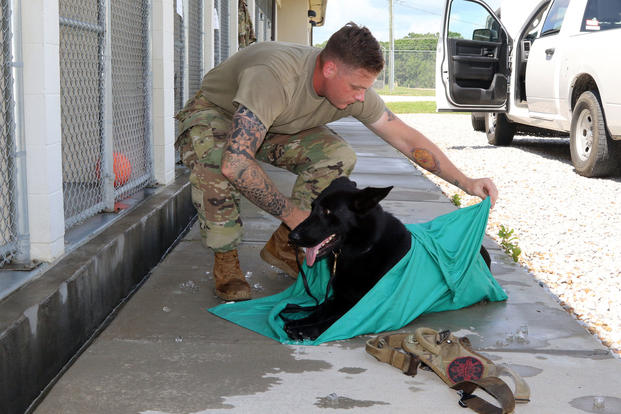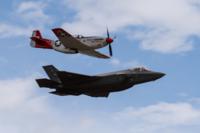It's hot out there, and the heat of the summer can cause the same injuries to pets that it does to their owners.
Just like people, animals can experience dehydration and heat stroke. For animals such as cats and dogs, heat is released through their paws and by panting. An animal's body conducts heat from the environment much faster than it can dissipate that heat, thus making high temperatures and humidity detrimental to its health.
That's why it's important for pet owners to make sure that their pets have access to shade, shelter and plenty of water when left outside, said Capt. Sarah Gregory, the officer-in-charge of the Fort Campbell Veterinary Center, assigned to the Public Health Activity, Fort Knox-Fort Campbell branch, Fort Campbell Veterinary Services.
Pets that have short noses including boxers, pugs, Boston terriers and Persian cats are more susceptible to heat stroke, Gregory said. These animals' panting is not as effective because of their snub-noses.
"Heat stroke prevention is a big thing," Gregory said. "Pets are not to be [left] in cars when the weather is warm for any amount of time because [a car] can easily heat up into an inferno."
According to the Animal Medical Center of Southern California website at animalmedcenter.com, the "initial symptoms of heat stroke in dogs are characterized by unanticipated restlessness," it says.
"Signs of heat exhaustion include excessive or heavy panting, hyperventilation (deep breathing), increased salivation early and then eventual drying of the gums and mucous membranes as the condition progresses, weakness, confusion or inattention, vomiting or diarrhea and, sometimes bleeding," it continues.
"Among common behavioral changes are agitation, whining, barking and other signs of anxiety. Progressing from heat exhaustion towards heat stroke, there may be obvious paleness or graying to the gums, more shallow respiratory efforts and eventually slowed or absent breathing efforts, vomiting and diarrhea that may be bloody and finally seizures or coma" leading to death, it says.
It's not just pets that can have a hard time in the heat. Despite training to work in harsh weather conditions, military dogs also can sustain heat injuries. That's why their handlers take extensive precautions to prevent them.
The dog handlers of 510th Military Police Detachment (Military Working Dog), 716th Military Police Battalion, 101st Sustainment Brigade, 101st Airborne Division on Fort Campbell, Kentucky, care for their dogs by continuously monitoring them. During any training, handlers are required to have a thermometer to monitor their dog's working and resting temperatures.
Each dog's temperature is different, so handlers take precautions individualized for each dog, said Staff Sgt. Nicholas Iafelice, a Fort Campbell military working dog handler.
When a handler notices his or her dog's temperature is approaching an abnormal level a mandatory rest period is enforced.
During that time, the dog rehydrates in the shade and handlers conduct heat injury prevention measures if needed.
"If it's truly severe we use ice sheets, kind of like what we do for a Soldier," Iafelice said. "When it's less severe, we take cold water and put it under their arms and along their undercarriage and paws to cool them down."
During hot weather, the handler has access to a cooler filled with water, ice and bed sheets.
The ice sheet process is used to prevent further injury. The sheets are used to pack the dog's groin, armpit and neck area, which are considered hotspots. The dog can also be wrapped with ice sheets, cooling the dog down quickly and preventing further injury. Once wrapped in the ice sheet, the dog is given intravenous fluids before being transported to a veterinarian.
Military dog handlers are trained to react quickly with those special tools in an emergency situation, but pet owners should use different steps if suspect a heat injury.
"If a pet owner suspects their animal to be suffering from possible heat stroke, the cooling process can be done in different ways," Gregory said. "Owners can take towels soaked in lukewarm water and put them on their dog or cat, or they can spray them down with lukewarm water and then put a fan on them. The reason we don't use cold water is because we don't want to drop their body temperature too rapidly."
Dunking a pet in a pool of cold water can cause their blood vessels to constrict and send them into shock. Without special training, cold water can cause more harm than good, so it is recommended that owners use lukewarm water.
Heat injury can be detrimental to an animal's health in some cases it can even cause the pet's demise. Being able to recognize the signs and symptoms of heat injury and taking appropriate action can save an animal's life.
"[Pets] can deteriorate rapidly," Gregory said. "Having the owner start the cooling process before bringing the pet to the vet reduces the mortality rate, so long as they can get to a vet quickly."
There are a few extra risk factors that make a heat injury in a pet more likely. Overweight pets and those with a medical conditions including lung or heart disease are more likely to suffer in the heat. And, of course, it's also important to make sure your pet has shade and water when left outside.















